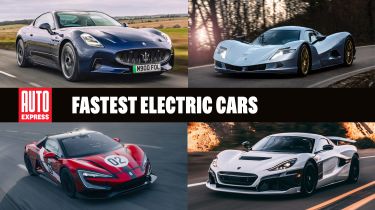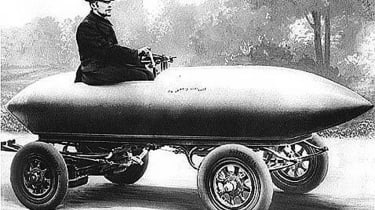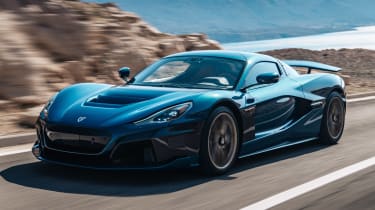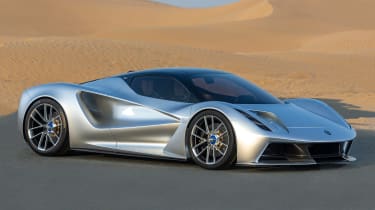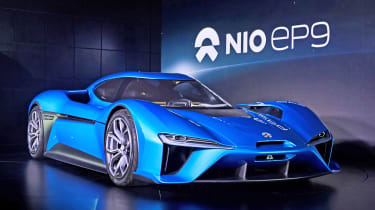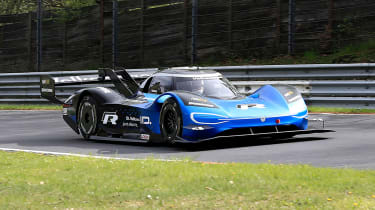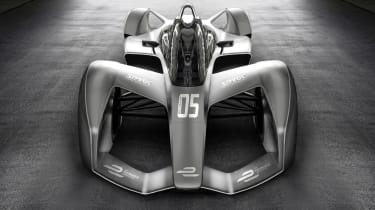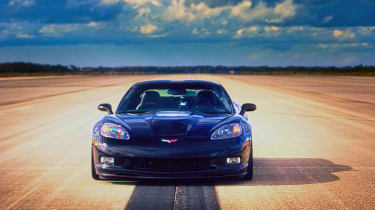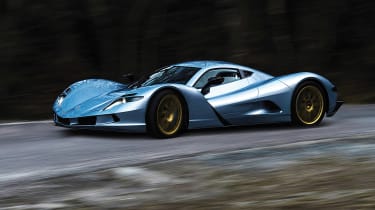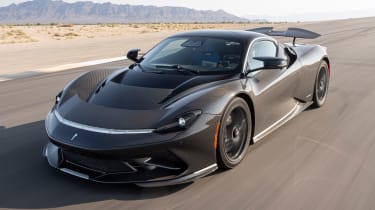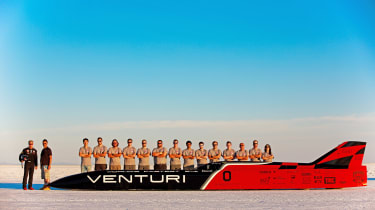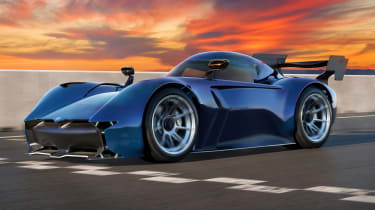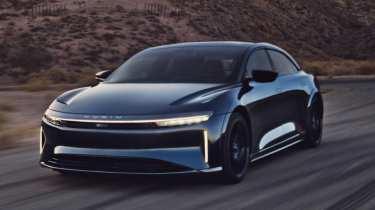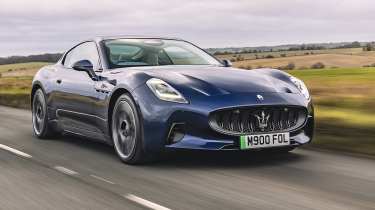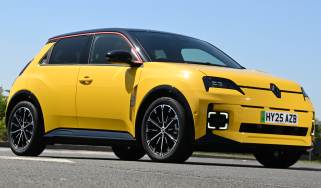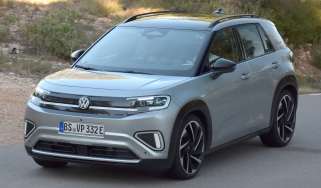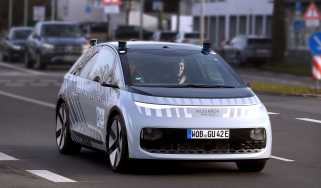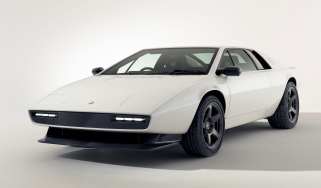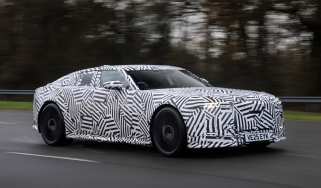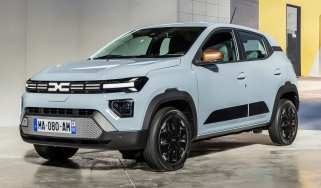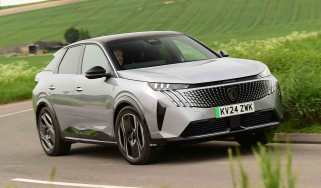Fastest electric cars in the world
We explore the fastest electric cars of the past, present and future
Electric cars are no longer a niche form of transport, looking to chip away at the dominance of the internal combustion engine. The electric car market is rapidly growing in popularity thanks to rapid improvements in range, charging infrastructure, driving dynamics and price – not to mention the impending ban on the sale of new petrol and diesel cars by 2030.
Another clear sign that EV technology is progressing is the rise in the number of manufacturers aiming to break electric car speed records. The title of ‘world's fastest electric car’ has never been more keenly contested and we even have an EV reigning as the fastest production car in the world. The growing importance of EVs has seen an influx of mainstream car makers announcing entry into fully electric motorsport, such as the Formula E electric single-seater championship, and this has helped advance the technology needed for ever-faster electric cars.
There was a time when a fast electric car meant a radio-controlled scale model. But today there are a variety of full-size speed machines on sale. The very highest-performance EVs are exclusive models built with six or seven-figure purchase prices, and here we’re rounding them up, along with some other cars that aren't quite in the realms of production.
Our list comprises one of the world's first Land Speed Record cars to show how far things have come, plus a couple of machines that can lap the Nurburgring Nordschleife like a GT3 racer and some models from the past designed with record breaking in mind.
Competition in the performance EV space is fierce and the variety of cars vying for assorted electric car speed records is diverse. Here we feature 15 cars that defy any preconception that EVs are dull…
The world's fastest electric cars
La Jamais Contente
- Top speed: 66mph
- 0-62mph: N/A
Before we get into the fast modern stuff, let’s take a look at the first fast electric car – La Jamais Contente (Translation: The Never Satisfied). It was made in Belgium (of all places!) that set the World Land Speed Record (LSR) in 1899 at a nosebleed-inducing 66mph or in other words, more than twice as fast as a Citroen Ami. It was the first car, with driver Camille Jenatzy at the wheel, to break an existing record, which incidentally was set by a different electric car a month earlier.
While it might look like a mix of a torpedo and a pram, it was aerodynamic for the time and was made from lightweight materials such as aluminium and magnesium.
The Belgians held the LSR for three years before it was bettered by a real automotive cul-de-sac, a steam-powered car that did 75mph. Later in 1902 a petrol-powered car went 1mph faster than that, then another steam car blitzed that record by hitting 128mph. However, after that petrol power took a foothold, before the jet and rocket-powered LSR age.
Tesla Roadster
- Top speed: 250mph+ (claimed)
- 0-60mph: 2.1 seconds (claimed)
There’s an enormous caveat to the sequel to Tesla’s first ever car, which is that despite it being announced all the way back in November 2017, we’ve seen and heard little more than a handful of “X” posts about it since. In fact, we’re not a long way off being as far from the second-generation Roadster’s announcement as the announcement itself was from the launch of the original Tesla Roadster back in 2008.
Still, Elon’s been pretty busy buying social media networks, siring children, struggling to sell Cybertrucks, and deconstructing the US government from within since 2017. He probably hasn’t had much time to concentrate on creating a performance car whose original claimed performance figures looked a lot more impressive before the likes of Rimac and YangWang came along with actual real-life cars and set real-world records.
Work on the 250-plus mile-per-hour, 2.1-seconds-to-62mph Roadster (which is actually more of a coupe) is apparently still ongoing though, with Musk suggesting in 2024 that the car’s ten cold-gas rocket thruster option would drop that 0-60mph time to less than a second.
Tesla’s vice-president of engineering suggested in July 2025 that a working Roadster could be demonstrated by the end of the year. The company is still taking $50,000 deposits for the car, and there’s no doubt that if it does arrive with the promised performance figures, and especially for the projected $250,000 or so, it’ll be quite an eye-opener.
Rimac Nevera
- Top speed: 258mph
- 0-62mph: 1.97 seconds
Rimac will be familiar to viewers of The Grand Tour, as it was the car that Richard Hammond crashed in Switzerland. Undaunted by the accident – and maybe courtesy of the publicity – the Croatian car maker followed it up with an even more potent electric hypercar, the Rimac Nevera.
Power is 1,888bhp from the four in-wheel electric motors and there is 2,360Nm of torque, which means the car can do 0-62mph in 1.97 seconds and hit 219mph flat out. That’s not all, because Rimac says the Nevera is “delivered to customers with a limited top speed of 219mph, but each one can achieve 258mph during customer events with the support of the Rimac team”.
There's some hi-tech energy storage on board, too, as the Nevera gets a 120kWh lithium manganese nickel battery pack, and this can be recharged to 80 per cent in just half an hour. With a full charge you can travel up to 341 miles, although not necessarily at 258mph. There's a host of hi-tech features, too, including Level 4 autonomous driving, a driver coach to teach owners the right racing lines at race tracks across the world and facial recognition to lock and unlock the car.
The Nevera’s performance figures compare favourably with the Concept One, which had 1,224bhp, 1,600Nm and a 210-mile range. The only downside is that there doesn’t seem to be much of a market for the car, with even company founder Mate Rimac admitting that buyers at this level (in the £2m bracket, for the Nevera) want something more analogue. As of 2024, Rimac had sold just 50 of the 150 planned Neveras.
Lotus Evija
- Top speed: 217mph (limited)
- 0-62mph: <3.0 seconds
The fully electric Lotus Evija hypercar is unlike anything else the British sports car maker has made before. As well as ushering in a new era of electrified performance for the marque, it also promises to be a huge leap in capability over every other road-legal Lotus that’s gone before. Lotus claims a top speed of 217mph is possible (matching the Pininfarina Battista elsewhere on this page), while an unspecified (but clearly very quick) 0-62mph time of “under three seconds” is also on the cards.
That incredible on-paper turn of speed is down to the huge amount of power at the Lotus Evija’s disposal – each wheel is powered by an electric motor and these produce a mighty 1,972bhp combined.
The 70kWh battery pack isn’t huge by modern standards and it’ll do 196 miles on that, which isn’t spectacular either (that’s 15 laps of the Nürburgring, says Lotus, though you probably won’t get 196 miles at Nürburgring speeds…). But for short, sharp blasts of rampant acceleration, the Evija certainly has the juice.
Nio EP9
- Top speed: 194mph
- 0-62mph: 2.7 seconds
Here's an EV that looks more like a full-size R/C car than average. The Nio EP9 is the flagship model for Chinese electric car start-up Nio, and it's similar in concept to the Rimac and Lotus. It has in-wheel motors for four-wheel drive, and it makes 1,341bhp in total. Nio claims a range of 265 miles, which was better than the Concept One and Evija, although Nio has added the ability to swap batteries for fully charged replacements (another nod to the world of R/C cars) in just eight minutes.
Under the skin, the carbon fibre chassis is built to Le Mans specification, while an active suspension system keeps things level. This combination of tech meant the EP9 lapped the Nurburgring Nordschleife in 6:45s – just ten seconds slower than the current overall production car lap record holder, the Mercedes-AMG One.
And yes, it is a production car, as six had been sold as of 2023, while another 10 will be built, albeit for £1million each.
Volkswagen ID.R
- Top speed: 170mph
- 0-62mph: 2.3 seconds
Including the Volkswagen ID.R in this list is admittedly a bit cheeky of us. After all, it isn’t a production car and, while a 0-62mph time of 2.3 seconds and a 170mph top speed aren’t anything to be sniffed at, they are overshadowed a bit by some of the electric hypercars on this list.
However, there’s no denying the ID.R is a fearsomely effective beast out on the race track. As well as being the fastest electric car around the Nurburgring Nordschleife (with a lap time of 6min 05sec), it also holds the outright record at the fearsome 12.42-mile Pikes Peak Hill Climb (7min 57sec), though its 39.9-second run at the Goodwood Festival of Speed in 2019 has since been beaten by the McMurtry Spéirling.
We won’t get to see how fast an upgraded and improved version of the ID.R could go, though, as the car has since been retired from record-breaking duties as part of VW’s reorganisation of its motorsport programmes.
Spark Gen3 (Formula E)
- Top speed: 200mph+
- 0-62mph: Sub-2.8 seconds (est)
Road-legal hypercars and one-off prototype hill climb racers aren’t the only cars that are embracing electric tech. A sizeable selection of fully-electric racing championships are up and running, too, and a number of other motorsports series have also expressed an interest in eventually ditching combustion engines for battery packs and electric motors.
Of that crop of electric racing disciplines, the one that boasts the fastest cars is the Formula E single-seater series. While they don’t have the outright power and acceleration of today’s hybrid Formula One cars, the Formula E cars still have quite the turn of speed.
The Gen3 cars were introduced in Formula in 2022, upping power from 270bhp to 450bhp and increasing top speed to over 200mph from 174mph.
Unlike some other racing championships, the Formula E series is a one-make spec series – while the motors vary between the teams. As before, all entrants must use the same chassis that’s designed and built by Spark Racing Technologies, and use the same spec of battery pack. Despite the technical limitations, Formula E has managed to attract a lot of interest from manufacturers – DS, Nissan, Jaguar, Porsche and Maserati all have teams in the championship.
Genovation GXE
- Top speed: 211mph
- 0-62mph: 3.0 seconds (est)
This might look like a C7-generation Corvette but Genovation has created a unique chassis and running gear underneath that familiar body. There's aluminium construction to counter the weight of the batteries, and while they only give a range of around 175 miles, there is genuine 200mph ability from the car – Genovation claims it’s clocked the car at speeds of up to 211mph, and says the production-ready version will be able to exceed 220mph.
While the C7 Corvette produced 461bhp in standard form, Genovation’s creation puts out 811bhp and 973Nm of torque.
Aspark Owl
- Top speed: 248mph
- 0-62mph: 1.7 seconds
Even by extremely powerful supercar standards, the Aspark Owl all-electric hypercar from Japan is quite a distinctive piece of kit. If its name alone wasn’t enough to provoke a reaction, the Aspark Owl also looks, for better or for worse, unlike anything else you’ll find in today’s supercar scene.
More outrageous still are the Owl’s claimed power and performance figures. Aspark says the car’s four electric motors produce a combined 1,987bhp and 2,000Nm of torque, which are enough to make the Owl the world’s most powerful production car. All that power and torque also, according to Aspark, means the Owl can accelerate from 0-62mph (albeit with a one-foot roll-out) in a Formula One car fast 1.7 seconds, and travel flat out at up to 248mph.
Pininfarina Battista
- Top speed: 217mph
- 0-62mph: 1.9 seconds
The Pininfarina Battista is named after legendary car designer Battista Farina and this all-electric hypercar certainly has the performance to back up this honour. Four electric motors powered by a 120kW battery means there’s a substantial 1,873bhp and 2,300Nm of torque on board – sent through a four-wheel drive system. A 1.9-second 0-62mph time can challenge the quickest cars on this list and the 217mph top speed matches Ferrari’s current halo car, the Le Mans-inspired F80.
Just 150 examples of the Battista will be made at a price point of around £2million.
Buckeye Bullet 3
Credit: Shiv Gohil / Spacesuit Media
- Top speed: 340mph
- 0-62mph: N/A
Going for fast 0-60mph times is quaint, when you compare to the top speed achieved by the Buckeye Bullet, the world's fastest electric vehicle. This streamlined racer was created by Ohio State University with help from French firm Venturi, and took to the Bonneville Salt Flats in September 2016 to set a new electric Land Speed Record of 342.144mph. To put that into context, the first internal combustion-engined car to break 340mph did it back in 1938…
The Bullet is a one-off machine with the front and rear axles powered by two electric motors each, and with the cockpit set low between the axles. It has a two-speed transmission, with first gear suitable for speeds up to 275mph.
While 342mph is the current record, further attempts will eventually see the Bullet break 400mph. In addition, the team behind the Bullet is also developing a hydrogen-powered streamliner.
McMurtry Spéirling
- Top speed: 185mph
- 0-62mph: 1.55 seconds
In this company a top speed of 185mph doesn’t look all that spectacular, but that’s so clearly not the point of the barmy McMurtry Spéirling that it doesn’t matter if it falls a bit short of the double-ton.
For a start, just check out its other headline figure: 0-62mph in 1.55 seconds is truly remarkable. The race for quicker and quicker acceleration times has been getting a bit daft for a while now but with fans actively sucking the Spéirling to the road acting like high-speed downforce and resulting in incredible traction, the tiny British bolide is a real mic-drop when it comes to reaching that benchmark 100km/h.
The small matter of a thousand electric horsepower helps too, of course, but the fans, which can generate two tonnes of downforce from a standstill and let it corner at 3g, are what gives the Spéirling an edge no other car here can match. Not even the Volkswagen ID.R, given in 2022 it dethroned the VW as the fastest car up the Goodwood Festival of Speed hillclimb. And yes, McMurtry has even proven it can drive upside down…
YangWang U9 Xtreme
- Top speed: 308mph
- 0-62mph: <2.6 seconds
Expect to hear a lot more about the YangWang U9 Xtreme over the next few years. The ultimate version of the U9 from YangWang, the luxury car arm of electric car giant BYD, was only announced in September, but YangWang didn’t just fire out a half-hearted press release – it announced that the Xtreme had set both a Nürburgring time of under seven minutes, and also become the fastest production car in the world, with a top speed of 308.33mph, beating the 304.773mph of the Bugatti Chiron Super Sport 300+.
It’s probably pretty quick to accelerate too, though as YangWang hasn’t announced a figure for that, we’ve gone with the sub-2.6 second time of the regular U9. Top speed is a very different ball game to acceleration, so to achieve that mindblowing 308mph figure, the Xtreme’s four motors deliver a combined 2,977bhp – also making it the world’s most powerful production car.
The U9 Xtreme is unlikely to warm the hearts of the kind of customer putting their name down for Bugatti’s upcoming V16-powered Tourbillon or the screaming GMA T.50, and other companies are sure to have a crack at the Xtreme’s top speed both combustion-powered and EV. But BYD and YangWang have certainly got their name in the record books.
Lucid Air Sapphire
- Top speed: 205mph
- 0-60mph: 1.89 seconds
More than a decade ago Tesla showed you could get supercar-style performance from a regular four-door executive car. These days, it’s the Lucid Air Sapphire that rules the roost. The elegant 5-Series-sized saloon has already won plaudits for the way it looks and drives, but in Sapphire form it’s also one of the quickest cars on sale anywhere.
205mph is already pretty good going - it’s 15mph beyond a BMW M5 with the M Driver’s Pack and its raised limiter – but the real eye-opener is the 1.89-second 0-60mph time, quicker than the 1.98 seconds of a Tesla Model S Plaid or the 2.2 seconds (to 62mph) of a Porsche Taycan Turbo GT Weissach.
It achieves its acceleration by way of a triple-motor setup producing a combined 1,234bhp, and with separate motors for each rear wheel, it’s also capable of torque vectoring in corners. Perhaps most importantly, it’s also just a real, usable car, with a spacious interior and a high standard of trim – far from being a one-trick pony.
Maserati GranTurismo Folgore
- Top speed: 202mph
- 0-62mph: 2.7 seconds
The GranTurismo Folgore is not an all-time great Maserati, but it is a very, very fast one. A top speed of 202mph from an electric car isn’t bad going, especially when that’s 3mph more than even the petrol-powered GranTurismo Trofeo can manage, and the Folgore is quicker-accelerating too: 0-62mph takes 2.7 seconds, compared to the Trofeo’s 3.5.
A trio of electric motors developing a combined 751bhp is behind that, while the Trofeo’s 2.9-litre turbocharged V6 makes “only” 542bhp. If even the Folgore’s output seems a little low compared to some of the other cars on this list, the figures suggest it makes good use of what it has (and illustrates the diminishing returns you get with ever more power and weight).
What the Folgore also shows is that performance isn’t the be-all and end-all of a luxury sports GT. Impressive though it is, we’d take the £160k Trofeo every time over the £180k Folgore, and not just because it’s cheaper. Lighter weight for better handling, a more useful touring range (we’ve found the Folgore gets only around 200 real-world miles, compared to the quoted 280), and the howl of its engine all still work in petrol power’s favour, with this particular car at least.
Now you can buy a car through our network of top dealers around the UK. Search for the latest deals…

